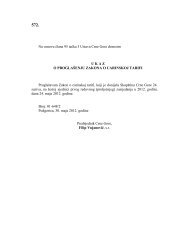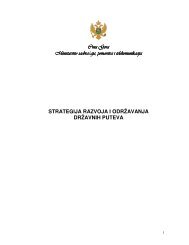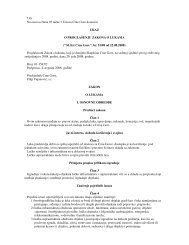pravilnik o zvanjima i ovlaÅ¡Äenjima o osposobljenosti pomoraca
pravilnik o zvanjima i ovlaÅ¡Äenjima o osposobljenosti pomoraca
pravilnik o zvanjima i ovlaÅ¡Äenjima o osposobljenosti pomoraca
You also want an ePaper? Increase the reach of your titles
YUMPU automatically turns print PDFs into web optimized ePapers that Google loves.
175<br />
– filter units cleaning<br />
times<br />
– emergency remote<br />
control<br />
– fuel overflow<br />
– emergency bilge<br />
pump<br />
– sounds and air pipes<br />
– pump type<br />
– electromotor type<br />
– type of the<br />
electromotor starter<br />
Note: Apprentice must not enter in closed spaces without permission of duty officer<br />
It is very important that engineer officer knows position of all pipings onboard, especially in engine room. Also very important to<br />
know is kind, pressure and temperature of fluid passing through pipings.<br />
Piping must be correctly marked with colour, direction of flow, pressure, temperature and possible hazards of the fluid passing<br />
through. Marks must be clearly visible, with instructions about colour meaning, showed on the visible place.<br />
Dismantling of any pipe must not be started before all safety precautions are taken. It It is necessary to write down in log book when<br />
some part of the piping is insulated.<br />
After assembling of the piping, before opening of the fluid it is necessary to check for any potential leak, especially for the steam<br />
pipings where exists a risk of »water hammer« which can cause a big damage. During familiarization with pipings it is very important<br />
to get acquainted with construction of the piping especially with parts for compensation of linear dilatation. Engineer must be familiar<br />
with position and function of all valves and other elements of the piping systems such as (filters, excess pressure valves etc.)<br />
Of great importance is maintenance of equipment for remote control of the valves.<br />
Fuel pipings must be known very well to avoid pollution of the space and environment.<br />
During bilge pumpings a great precaution must be taken to avoid sea pollution, because of that in case of an emergency other<br />
pumps can also be used for bilge pumping.<br />
When you are getting familiar with pipings remember position and function of the all control valves. If you are using oily water<br />
separator that must also written in log book.<br />
2. ENGINE ROOM TANKS AND ADJACENT COFFERDAMS<br />
TASKS<br />
SERIAL<br />
NUMBER<br />
OF THE<br />
SHIP<br />
DATE<br />
TASK DONE<br />
DUTY<br />
OFFICER<br />
CHIEF ENG.<br />
SIGNATURE<br />
REMARKS<br />
1. Name all tanks and<br />
cofferdams in the<br />
engineroom<br />
2. Describe level<br />
indicators, their use<br />
3. Describe filling and<br />
overflowing of the<br />
tanks<br />
4. Mark position of all<br />
quick closing valves<br />
5. Mark position of all<br />
remote closing<br />
devices<br />
6. Describe potential<br />
risks when entering<br />
closed spaces<br />
Consider position and function of all tanks and cofferdams in the engineroom.<br />
Cofferdams are safety spaces which separate tanks, so that any leakage can be easily located and repaired. It is necessary to<br />
control the cofferdams by measuring the level, or visually.







